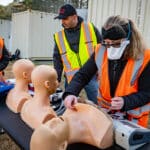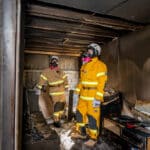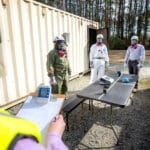Fanning the Flames of Textile Science
In its 30th year, the Textile Protection and Comfort Center celebrates the breakthroughs that have inspired its faculty, staff and student researchers with purpose — and ignited innovation across the world of textiles.
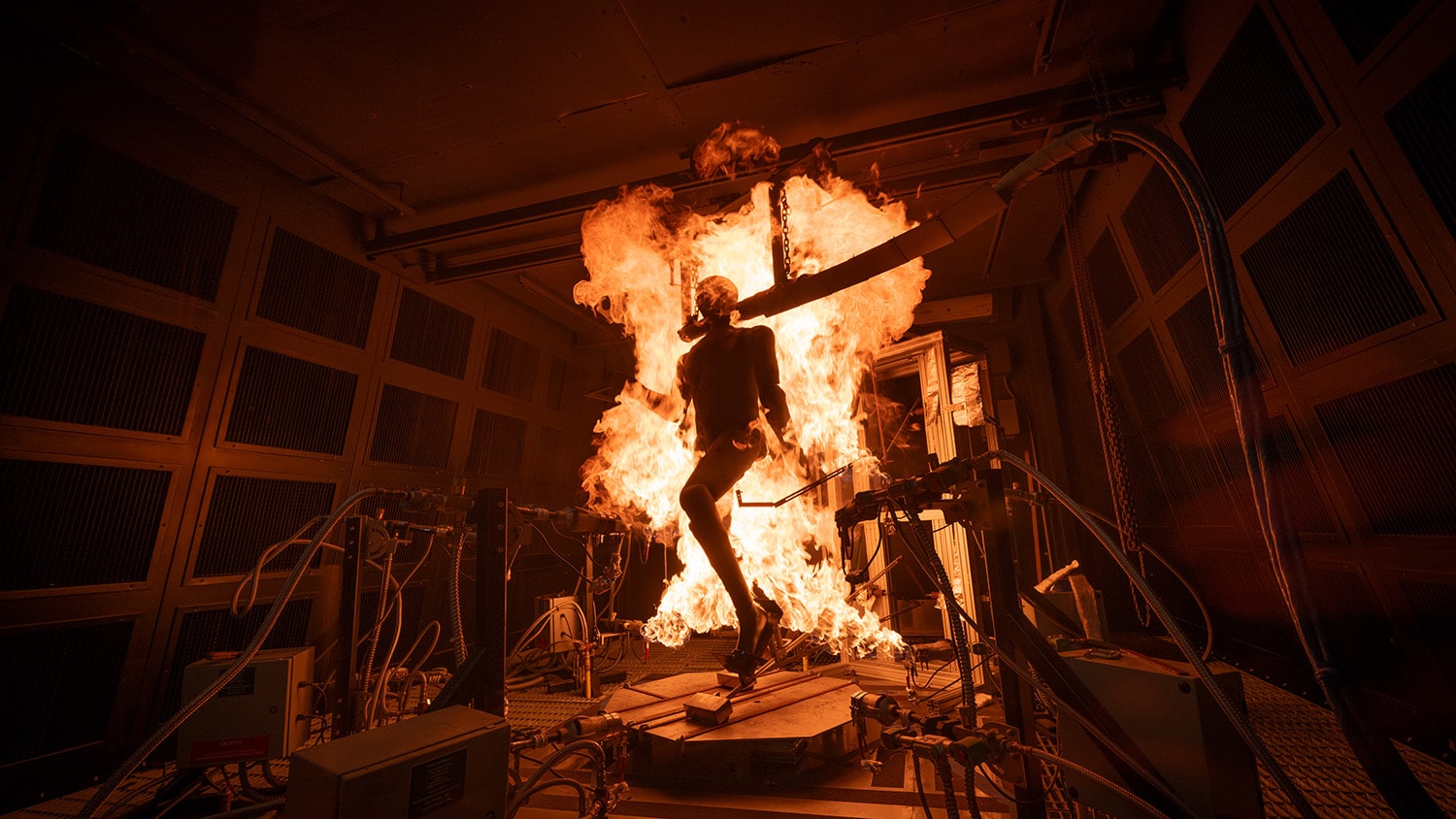
Behind the brick facade of the Wilson College of Textiles, a manikin named Liz provides data on how unisex first responder uniforms perform on female bodies. Tucked away from the lobby displays of gowns made from sustainable materials, another manikin sweats while wearing cutting-edge textiles made for sportswear, helping student researchers collect data on how the fabrics help regulate body temperature. A third, dubbed Dynamic PyroMan, is set in motion — and on fire — behind protective glass, revealing how a firefighter’s ensemble might perform while running through flames.
These testing labs are part of Wilson College’s Textile Protection and Comfort Center (TPACC), a research facility dedicated to pioneering and testing the comfort and protective performance of textile materials and garments. This year, TPACC commemorates its 30th anniversary. Founder and Director Roger Barker has much to celebrate, having built the center from the ground up.
I was able to say from the outset in 1994 that we can bring solutions to these problems through facilities and expertise that would be available nowhere else in the world.
While working at Cornell University, Barker became interested in researching heat- and fire-resistant materials. After coming to NC State in the early 90s, he started to develop measurement technology, responding to what he saw as gaps in the ability to accurately test textiles for protection and wearability.
“I was able to say from the outset in 1994 that we can bring solutions to these problems through facilities and expertise that would be available nowhere else in the world,” Barker said. This realization spurred him to consider creating a dedicated research center. Through a formal process, Barker proved to the UNC Board of Governors that such a facility would serve a purpose not only for North Carolina but for the entire country — and beyond.
Thermal Science
Hazardous occupations such as military personnel, firefighters, welders, molten metal workers, astronauts, or race-car drivers require clothing materials tested for protection against heat and flames. TPACC takes these textiles to the test in its specialized labs.
Chemical Protection
The Chemical Protection Laboratory uses state-of-the-art equipment to analyze materials for penetration, permeation, and infiltration resistance of potentially toxic chemical liquids and gases.
Comfort and Performance
Consumers are persuaded not only by a product’s design but also by how it feels and performs in certain climates or activities. TPACC’s comfort lab explores the science behind these variables.
TPACC was created and dedicated in many ways to the paradox between the comfort and safety of protective clothing, such as first responder PPE or a firefighter’s uniform (aka “turnout”) ensemble.
“There’s always a trade-off between properties,” Barker said. The more protective a garment might be, the less comfortable it is — and vice versa. “I always like to say that TPACC was built on trying to find the best balance.”
In addition to conducting research that improves first responders’ personal protective equipment (PPE), TPACC has become a resource for testing and innovating textile technology used in everyday functional clothing, especially sportswear.
“We work with all the major brands in that area as they come up with a magic — or what they think is a magic — wicking treatment for fabrics,” Barker said. Part of what TPACC accomplishes with its state-of-the-art research facilities is separating the high-tech from the hype for consumers. “We’re there to provide them with an independent, unbiased qualification for that.”
Dedicated Staff, the Unsung Heroes
TPACC conducts research with immediate, real-world applications. “We support much of our own operating expenses, and that means we have to do work that people value in real ways,” Barker said. “The job isn’t easy.”
It’s not all about our equipment, manikins and flashy things. It’s about the people who make them work.
The staff of TPACC have enabled the center to endure for the last 30 years, Barker said. As resources of technical expertise, TPACC staff provide essential support to faculty and student research. They’ve developed testing methods that make the center’s work unique and unable to be easily duplicated.
“It’s not all about our equipment, manikins and flashy things,” Barker said. “It’s about the people who make them work.”
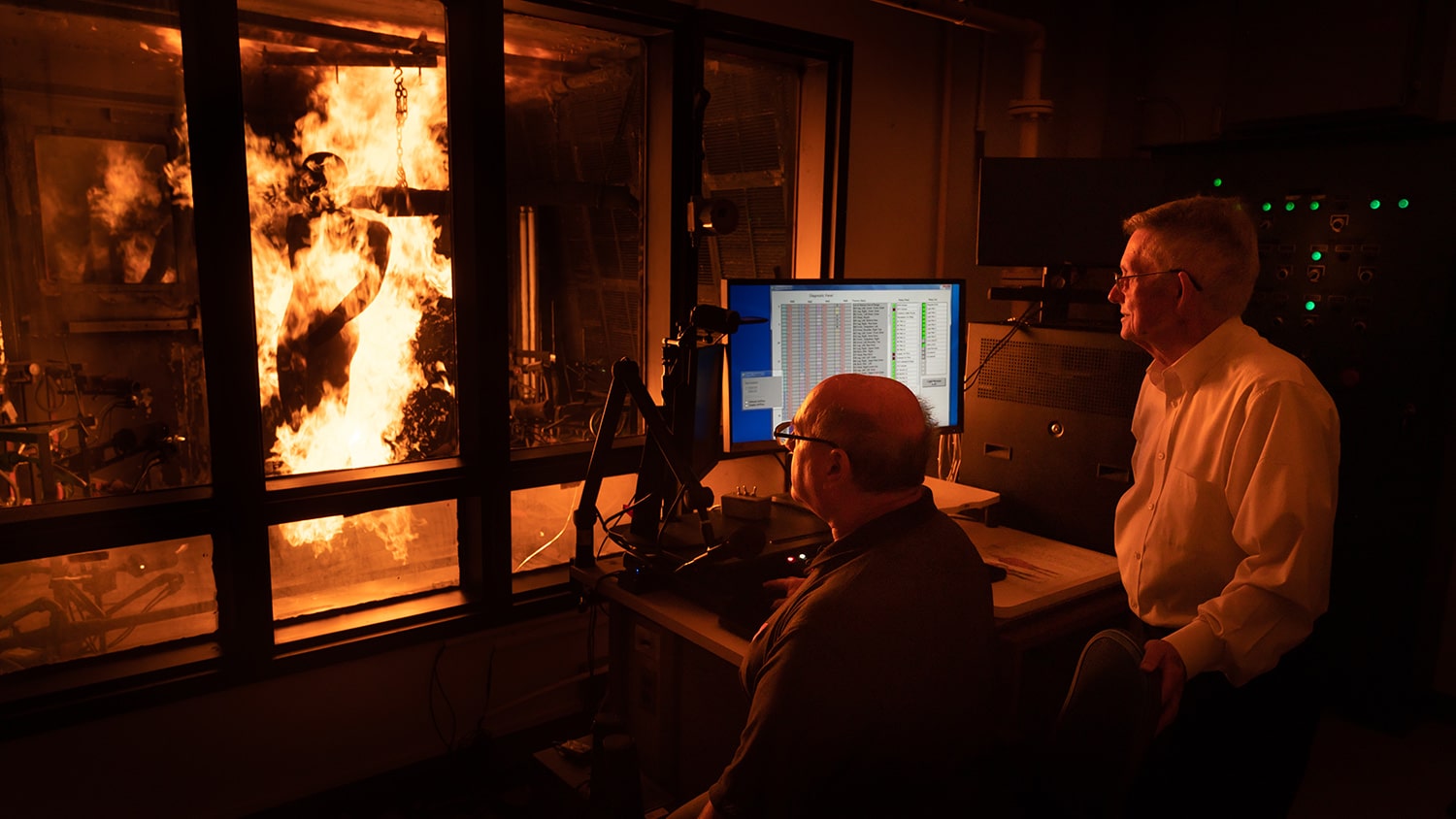
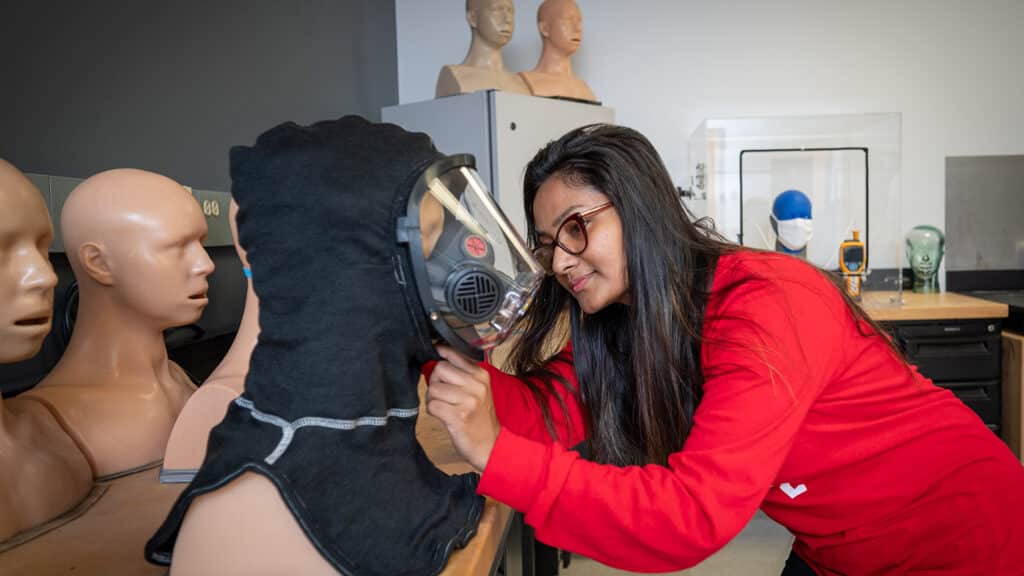
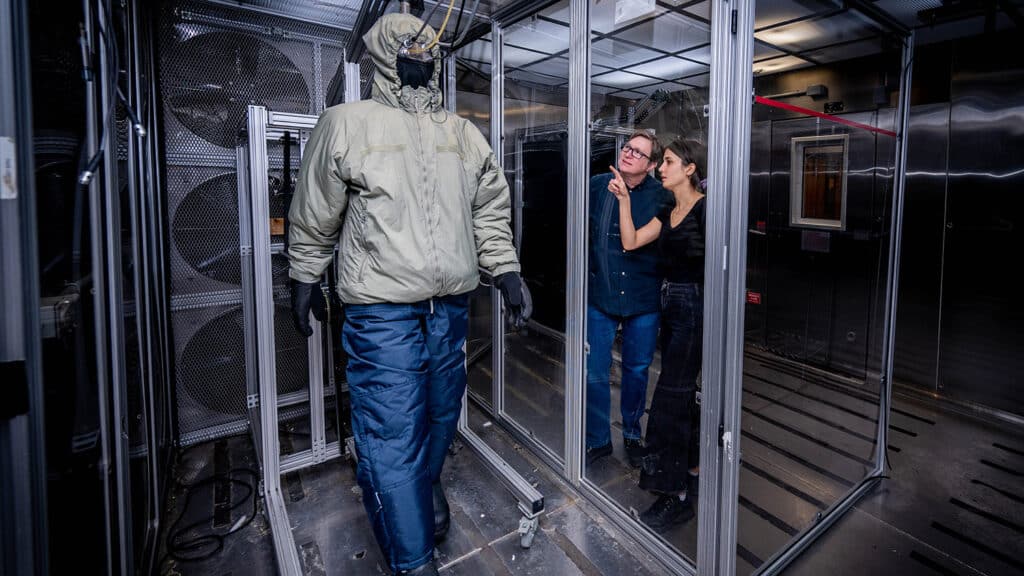
Shawn Deaton is the deputy director of TPACC and a two-time alumnus of the college who worked in manufacturing at Dupont between earning his bachelor’s and master’s degrees. He got involved with TPACC as a graduate student, and after completing his degree, he applied for a position to run the thermal facility. From working in a project management role, then as operations director and now deputy director, Deaton has seen TPACC grow and evolve. When he first started, TPACC comprised two basic labs — one for testing thermal capabilities and another for comfort or wearability. Then 9/11 happened.
Deaton remembers the day. The TPACC team was in Maryland getting ready to present research at the National Institute of Standards and Technology when they learned that the Pentagon had been attacked. The meeting was canceled, and the team struggled to return to North Carolina because the freeways were blocked. (“It was a long day,” Deaton said.) But it also became a defining moment as TPACC became one of the first organizations to receive major funding from the newly created Department of Homeland Security. The center was called on to help develop a new kind of firefighter turnout with chemical protection, similar to a hazmat suit. Sept. 11 became a moment when the types of research that TPACC focused on gained wider attention.
“It propelled the country to start looking at PPE, particularly for firefighters at that particular point in time, and taking that a lot more seriously,” Deaton said.
Almost two decades later, another event would underscore the importance of TPACC’s work. The COVID-19 pandemic presented a new critical need, as the world grappled with the importance of PPE in the form of face masks. Despite downsizing its operations in response to the pandemic, TPACC modified its existing equipment to contribute to the research, measuring the effectiveness of face masks to protect against particle exposure. Deaton said the priority always is to serve by providing research-backed information to the public. The center’s strength lies in its ability to respond to the challenges of the moment.
Today, there are seven labs that research chemical protection, comfort performance and thermal level protection. The research manikins have also expanded in range and capabilities. Currently, there are two thermal manikins dubbed PyroMan and Dynamic PyroMan. For comfort research, two male manikins and one female manikin can mimic how the human body sweats.
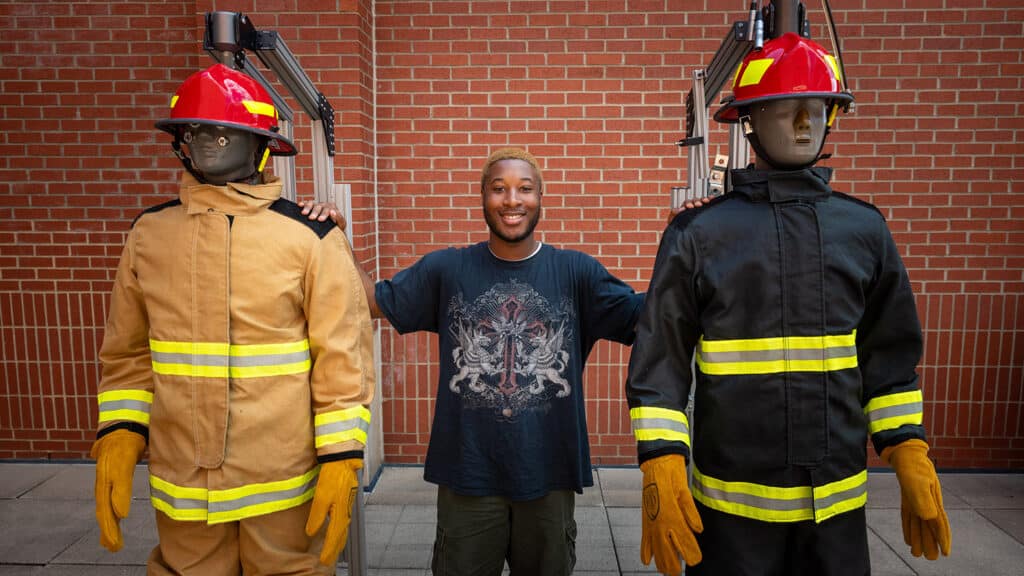
TPACC collaborates with interdisciplinary teams to envision new possibilities. For one project, the center worked with the forestry department at NC State to develop a new fire shelter for wildland firefighting.
“We certainly understand how to measure and evaluate the thermal response,” Deaton said. “But just understanding how things are out there in the real world, in a wildfire situation, we needed their assistance.”
The research teams could more accurately design a fire shelter to respond to the specific intensity of burning grasses or other ground cover plants by tapping into the forestry department’s expertise.
Similarly, getting real-world input from the people who wear and rely on the textiles and garments is part of TPACC’s ethos. For Assistant Professor Bryan Ormond, that is the element of his job that clarifies the purpose of his research. Teaching in the Textile Engineering, Chemistry and Science (TECS) Department with a joint appointment in TPACC, Ormond has dedicated much of his research to trying to solve the problems of firefighter PPE. The flame retardant chemicals that are used on their protective uniforms are carcinogenic and have been linked to high rates of cancer among firefighters. While Ormond leads research that influences standards set by national and international committees, he never loses sight of what this research means to firefighters and their loved ones. “If we can stop one firefighter’s family from having to hear that [their loved one has cancer], it’s all worth it,” Ormond said.
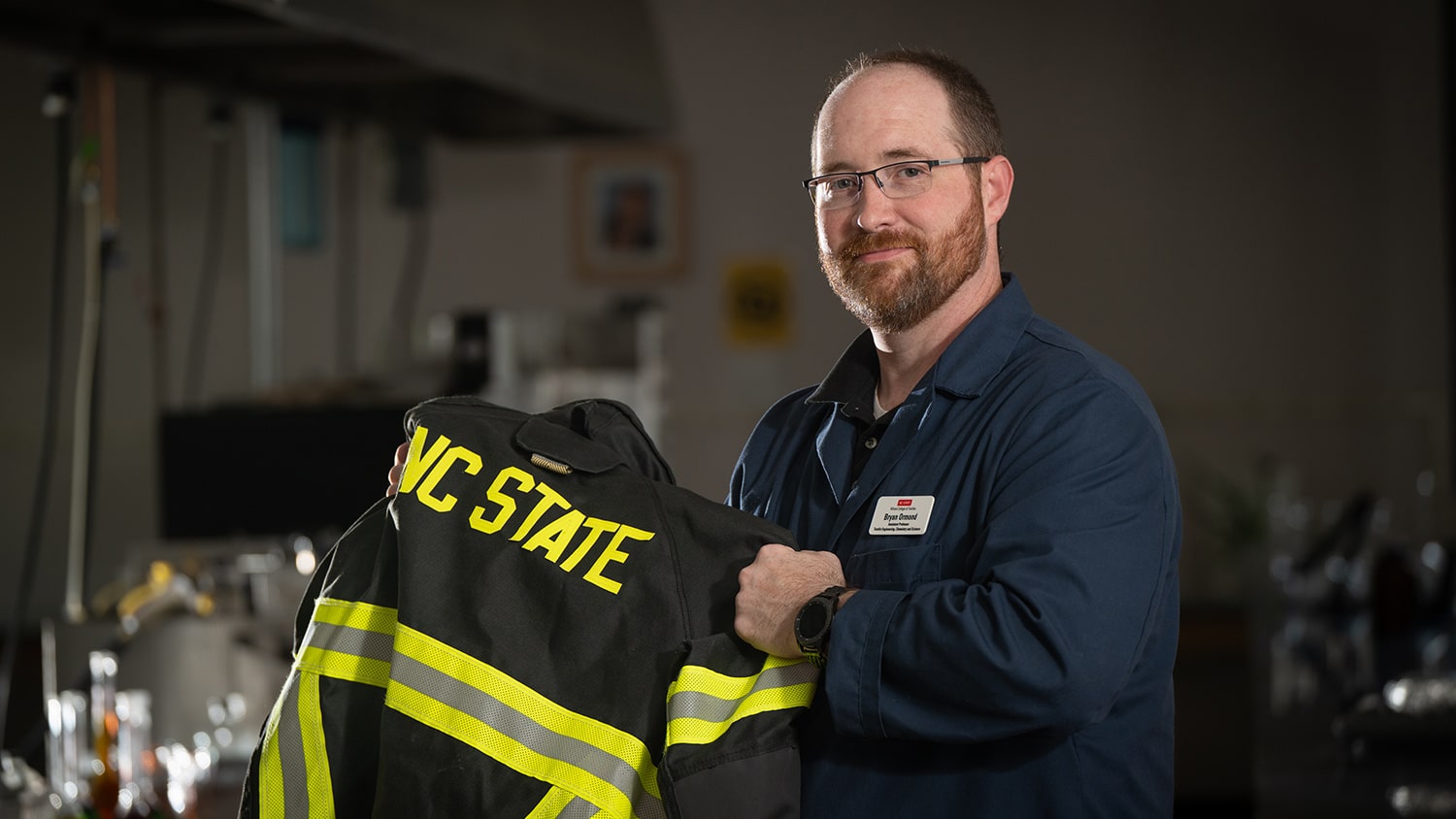
He values bringing that sense of purpose to his students through immediate hands-on experiences. He works closely with fire departments or volunteer crews around the country, and in 2019, the Cary Fire Department called and asked if he wanted to put his graduate students in a burning building.
“I said, ‘Sure, why not?'” said Ormond, the recipient of the 2021 Outstanding Teacher Award and the 2024 Distinguished Young Alumni Award.
Ormond and his students traveled to the site in Cary and put on the same gear and respirators that they were used to analyzing in a lab setting. As safely as possible, they entered a building that was being burned for the purpose of training firefighters. Wearing the turnout garments and dealing with the smoke and heat underscored the challenges of making gear that was protective and comfortable for firefighters to wear in emergency situations.
“I could see it on all their faces,” Ormond said. “They were like, ‘Okay, I get it. I understand.'”
Igniting Purpose: Student-led Research
Ormond relates to his students, having been one for so long. A two-time NC State alumnus, he received his B.S. in polymer and color chemistry (PCC) from the college in 2007 and continued on, earning a Ph.D. in fiber and polymer science. Ormond remembers not fully realizing at the start of college that studying the science and technology of textiles would prepare him for good jobs — and give him a way to help people.
Students driven by the motivation to help others often choose medical school because becoming a doctor is an occupation they’re familiar with.
“I think, ultimately, people want to be able to help people,” Ormond said. “They want to do something that’s useful, but they may not realize there’s a lot of jobs where you can do that.”
Ormond’s graduate — and even some undergraduate — students can get the chance to work on research in TPACC. Mackenzie Chorzelewski is an undergraduate who approached Ormond as a freshman about working in his lab through the Research Experience for Undergrads. With a father who is a retired Marine Corps officer and a former volunteer firefighter, she came to the college interested in textile protection and research. This summer, she is working with a research team led by Ph.D. student Mark Gaskill on a field trial, measuring contaminants through silicone disks placed inside the turnouts.
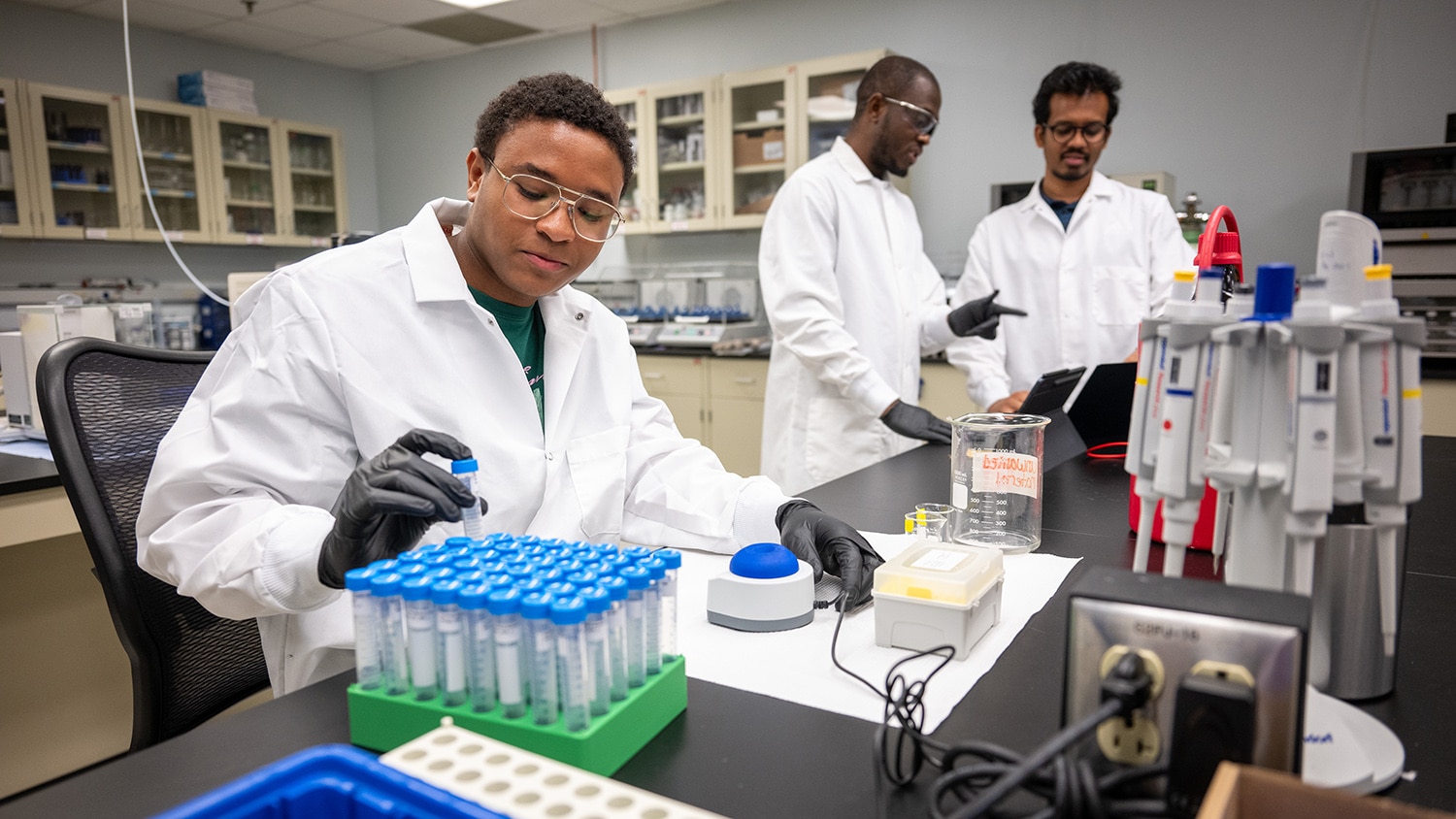
Another undergraduate student, Noah Putney, was initially interested in going into the medical field. However, he enjoyed Ormond’s classes in PCC so much as a sophomore that he has been part of the research process at TPACC for three years. Currently, he is assisting a graduate researcher in testing how fluorinated finishes — the fire-resistant coatings that contain carcinogens — leave fabrics during the laundering process and by entering the environment, could put ecosystems and human health at risk. Next, he will help test the flammability of nonfluorinated finishes on garments, which gets around the problem of exposure to carcinogens but could potentially expose the wearer to hazards like absorbing diesel fuel.
Ormond believes that the future of the textile industry lies in the hands of students like his, many of whom are passionate about sustainability. North Carolina has a long history and heritage in textiles, and the care and responsibility he sees in his students are crucial to evolving this legacy for the better.
Similarly, Barker is optimistic about TPACC’s future when considering its young, up-and-coming researchers and technicians. He said that TPACC is the only place in the country where students get involved in textile research projects with such direct relevance and job-ready real-world applications. When attending industry events or conferences, he enjoys seeing his students leading the research and conversations.
“I’m so proud of them because they’ve gone out and become leaders.”
- Categories:


